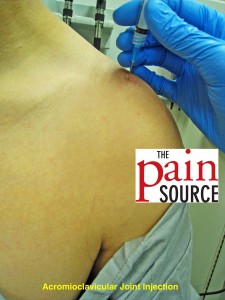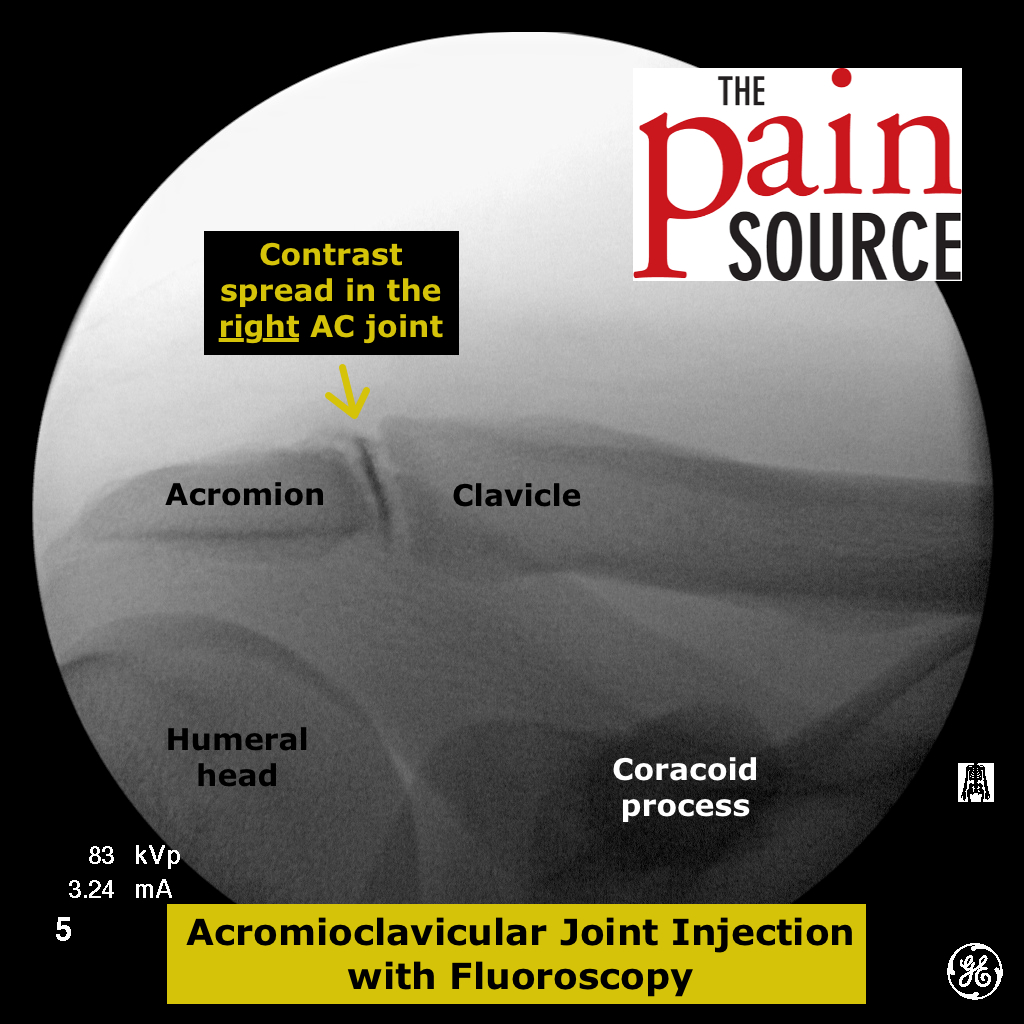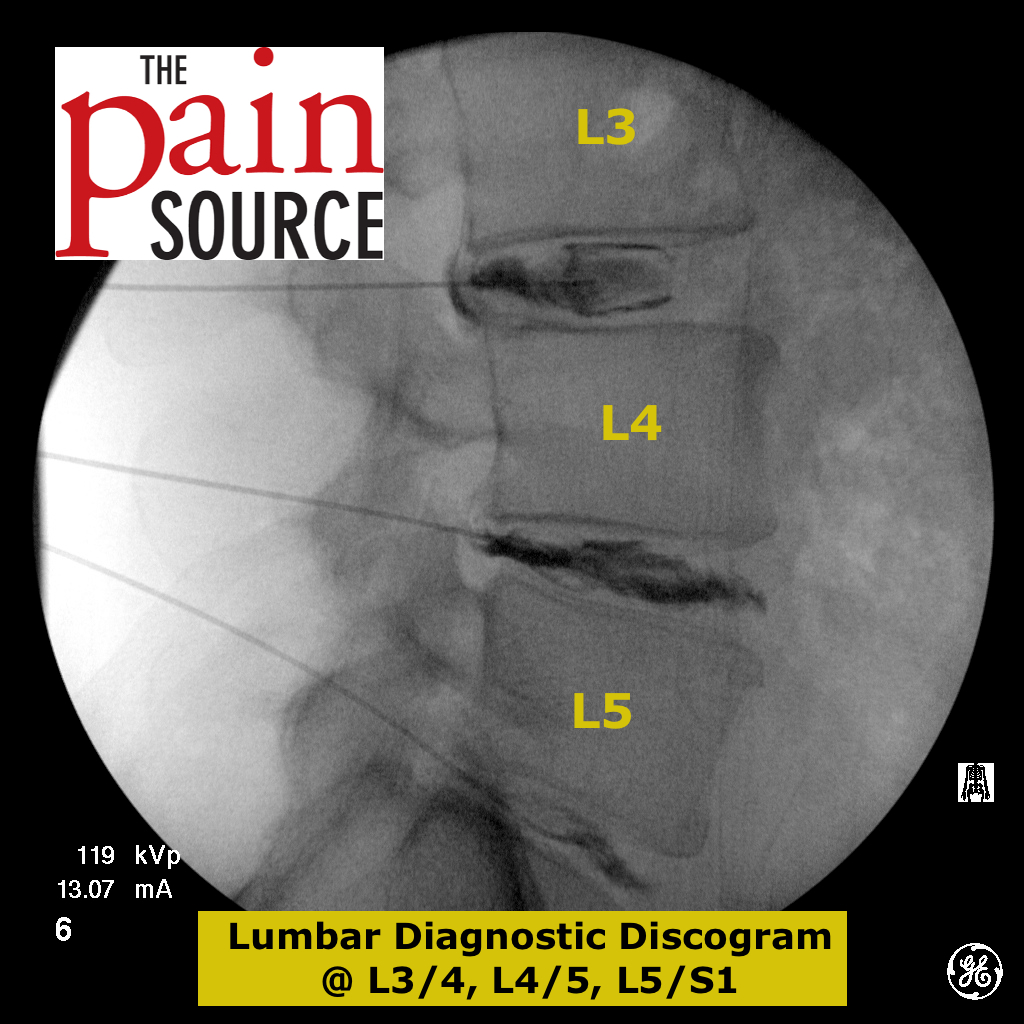By Chris Faubel, MD —

Indications
- Acromioclavicular joint osteoarthritis
- Acromioclavicular joint sprain
- Acromioclavicular joint separation
- **see all ICD-9 and ICD-10 codes at end of post
CPT code: 20605
Materials Needed
- Pen – clicking type
- Gloves – non-sterile
- Alcohol swabs
- Band-aid
- Tuberculin needle/syringe (27-gauge, 1/2″) OR 1-ml syringe with 25-gauge 1.5″ needle (depending on body habitus)
- 0.5-ml of 40mg/ml Depo-Medrol or Kenalog
- 0.5-ml of 1% lidocaine
Technique / Procedure Steps
- Always start with informed consent from the patient, and then a time-out to verify correct patient and injection site.
- Mark the injection site with the pen tip in order to leave an impression in the skin.
- Clean the skin thoroughly with as many alcohol swabs as needed (usually only one is needed).
- Patient position: seated (typically)
- With the tuberculin needle/syringe, enter the skin going straight down into the joint. If any periosteum is met with the needle tip, redirect. Typically need to use all of the 1/2″ needle.
- Aspirate to make sure you’re not in any vessel.
- After negative aspiration, inject the full contents of the syringe. Redirect or withdraw the needle slightly if it isn’t flowing easily.
- Withdraw the needle and apply band-aid.
Tips
- Finding the injection site
- Follow the acromion anteriorly with one hand, and the clavicle laterally with the other. Find that depression in the skin and mark with the pen tip to make an impression.
- Advance the needle from superior to inferior (cephalad to caudad)
- Numbing the skin
- Find out all about “Taking the Sting Out” (of injections) by going here.
- Since I use a tiny tuberculin needle, most patients have no problem with the injection and don’t need any extra lidocaine skin wheal or freezing spray.
- I tell them numbing the skin with lidocaine will probably hurt more than the actual injection.
- Procedure for a “pain free” injection
- Fill a 27G 1/2″ tuberculin syringe with 1-ml of 1% lidocaine.
- Use ethyl chloride spray to “numb” the skin over the injection site; then quickly create the skin wheal of lidocaine.
- Insert the tip of the needle just below the surface of the skin, almost at a parallel angle. Then inject about 0.25-ml to create the skin wheal.
- Redirect the needle perpendicular to the skin in the direction that your 25G needle will go, and inject the rest of the Tb syringe along the entire length of the needle.
- After the injection
- Have the patient move their shoulder for a few seconds. I show them some simple bent over Codman circles.
- Then, have the patient abduct their shoulder so they can see the immediate results of the lidocaine.
- Explain to the patient that the lidocaine will wear off in an hour or so, and that they will be back to their normal pain until the steroids start kicking in (anywhere from 1-7 days).
- May also ask the patient to not do much activity with that shoulder for 12-24 hours.
Diagnostic Codes
- Acromioclavicular (AC) joint osteoarthritis
- ICD-9 code:
- 715.91 “osteoarthrosis, unspecified whether generalized or localized, shoulder region”
- 715.11 “osteoarthrosis, localized, primary, shoulder region”
- 719.41 “pain in joint, shoulder region”
- 719.91 “unspecified disorder of joint, shoulder region”
- ICD-10 code:
- M19.011 “primary osteoarthritis, right shoulder region”
- M19.012 “primary osteoarthritis, left shoulder region”
- M19.019 “primary osteoarthritis, unspecified shoulder region”
- ICD-9 code:
- Acromioclavicular (AC) joint sprain
- ICD-9 code:
- 840.0 “acromioclavicular joint ligament sprain”
- ICD-10 code:
- S43.50 “sprain of acromioclavicular joint, unspecified side”
- S43.51 “sprain of right acromioclavicular joint”
- S43.52 “sprain of left acromioclavicular joint”
- ICD-9 code:
- Acromioclavicular (AC) joint separation
- ICD-9 code:
- 831.04 “closed dislocation of acromioclavicular joint
- ICD-10 code:
- S43.101 “unspecified dislocation of right acromioclavicular joint”
- S43.102 “unspecified dislocation of left acromioclavicular joint”
- S43.109 “unspecified dislocation of unspecified acromioclavicular joint”
- ICD-9 code:















